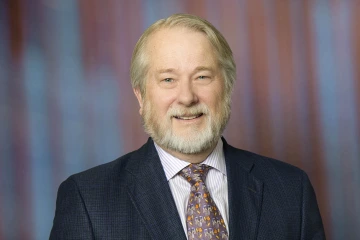State Tribal, Rural Areas Focus Internally for Nursing Needs
"Grow our own" is the mantra rural and tribal health care organizations refer to for nursing staff recruitment and retention.

Timian Godfrey, DNP, APRN, FNP-BC, addresses attendees at the 48th Arizona Rural Health Conference in Flagstaff, Arizona. Her presentation focused on innovative strategies to attract and retain nurses for rural and tribal communities. (Photo courtesy of University of Arizona Center for Rural Health).
Finding ways to train and keep nurses in rural, underserved and tribal areas in Arizona through youth pipeline, recruitment and retention programs are a critical part of “grow our own” initiatives to combat nursing shortages, said Timian Godfrey, DNP, APRN, FNP-BC, a University of Arizona College of Nursing assistant professor in the Community and Systems Health Science Division and instructor in the Doctor of Nursing Practice program.
National shortfalls in nurse staffing likely will get worse before they get better, despite relief from legislation and funding to support expanded education and training, Dr. Godfrey said during a presentation at the 48th Annual Arizona Rural Health Conference.

“We need to recruit people, support them through school and give them adaptable work schedules with opportunities to keep learning and advancing, especially when we talk about a diverse workforce,” Timian Godfrey, DNP, APRN, FNP-BC, said.
Academic and other post-graduate nursing programs ought to prepare to meet demand, Dr. Godfrey added. This could include collaborating to fill additional slots for education and training, including “transition to practice” programs that offer guidance on the job to help new nurses avoid burnout and strengthen job satisfaction.
“I think it’s important to look at this as a system,” she said. “It’s not just about addressing workforce shortages or education or policy. We really all must communicate better as a whole. To even produce the amount of nurses to meet the shortages, there has to be enough funding, and faculty and preceptors for clinical spots to educate and bring in the workforce that’s needed to meet the demand.”
The Arizona Area Health Education Center (AzAHEC) Program at the UArizona Health Sciences recently selected the Arizona Advisory Council on Indian Health Care to develop a new American Indian Health AHEC Regional Center dedicated to developing health profession education initiatives and expanding access to health care for tribal communities in Arizona.
The new American Indian Health (AIH) AHEC Regional Center will be the sixth AHEC Regional Center in Arizona. It is the first in the state – and one of few in the U.S. outside of Alaska – to focus exclusively on the American Indian health care system and its workforce. American Indians have some of the highest rates of health disparities, poverty and poor health outcomes when compared with other ethnic and minority communities in the U.S., according to the Indian Health Service.
The AIH-AHEC Regional Center will conduct training and coach individuals to become health care providers serving in their home communities.

Dan Derksen, MD, is the associate vice president of health equity, outreach and interprofessional activities for UArizona Health Sciences.
Efforts to boost health care careers in rural and tribal areas require more concerted and flexible options. Those areas, often more difficult to develop or attract staff to, were particularly stressed by the COVID-19 pandemic.
Dr. Godfrey added that even at larger Arizona health care organizations, some clinical units “aren’t operating to their fullest capacity, because they don’t have the nursing staff.”
The loss, as experienced nursing staff followed the money to become travel nurses and others simply retired in the pandemic, created additional gaps that meant new nurses might miss out on coaching and training from veteran nurses who act as preceptors. The results were reflected in a hospital turnover rate of nearly 28% for first-year nurses and those with 2-5 years of experience, the highest for all hospital employees, according to NSI Nursing Solutions Inc. in its 2022 National Health Care Retention & RN Staffing Report.
While it’s at the lower end of a growing gap between available jobs and people graduating from nursing school, Arizona ranks seventh in the country as a place to work by Becker’s Hospital Review and expects a 23% growth in demand for specialized nurses, with more than 20,000 new openings by 2025. That may attract nurses from out of state, but tribal and rural areas often must focus their recruiting efforts within their communities.
Dr. Godfrey, a Navajo Nation member, said UArizona Health Sciences has multiple pipeline programs to assist, including three federally funded College of Nursing programs. These include the SEW-RUN (Strengthening Eldercare Workforce through Rural and Underserved Nursing), ANCAT (Arizona Nursing Career Apex Transitions) and INCATS (Indians in Nursing: Career Advancement & Transitions Scholars) programs. Each are designed to help diversify the workforce.
“To increase our presence in health sciences and health professions, we need to help our own people to come into education through programs and policies like these.”
Timian M. Godfrey, DNP, APRN, FNP-BC
Those programs, and others at the College of Nursing, could benefit from a bill signed by Arizona Gov. Doug Ducey on June 29. House Bill 2691 dedicates $92 million over several years to address those challenges and grow the state’s nursing workforce. The bill provides $27 million for student nurse clinical rotations, $25 million of which will go to preceptor training programs and $2 million to nurse transition-to-practice programs.
It earmarks $15 million to establish the Arizona Nurse Education Investment Pilot Program, a partnership between hospitals and nurse education programs to expand more classroom seats for the profession. Additionally, $44 million is available for public and private universities and community colleges to grow accelerated nursing programs, $5 million to expand behavioral health training programs and $500,000 for licensed preceptors to supervise graduate students.
“To increase our presence in health sciences and health professions, we need to help our own people to come into education through programs and policies like these,” Dr. Godfrey said. “With this new legislation, once we know those clinical spots are confirmed, hopefully, we will be able to open up more spots for admission quickly. There are a tremendous number of students qualified who can be admitted but aren’t. Often, that’s because we don’t have the spots available for their training.”
Regardless of available spots, it takes time – up to five years or more – to gear up programs, hire faculty and preceptors, and recruit, educate and train new students and nurses, Dr. Godfrey said.
What’s important, Dr. Godfrey added, is “we all work together, coming at this from different angles for a systems approach to address this issue. We need to recruit people, support them through school and give them adaptable work schedules with opportunities to keep learning and advancing, especially when we talk about a diverse workforce. These are the people who’ll want to go back into their own rural communities to care for their families and loved ones. In that way, there’s a constant growing of our nursing workforce.”

